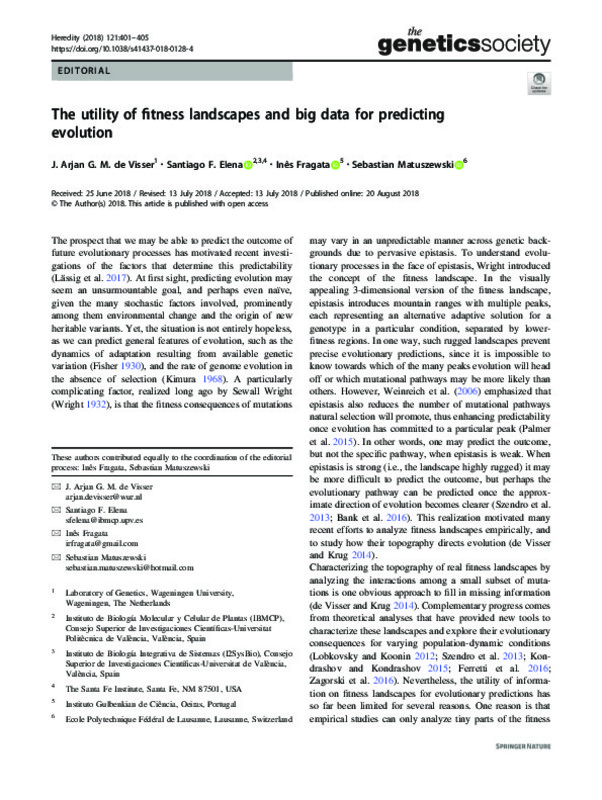Acevedo A, Brosdsky L, Andino R (2014) Mutational and fitness landscapes of an RNA virus revealed through population sequencing. Nature 505:686–690
Bank C, Matuszewski, Hietpas RT, Jensen JD (2016) On the (un)predictability of a large intragenic fitness landscape. Proc Natl Acad Sci USA 113:14085–14090
Blanquart F, Achaz G, Bataillon T, Tenaillon O (2014) Properties of selected mutations and genotypic landscapes under Fisher’s geometric model. Evolution 68:3537–3554
[+]
Acevedo A, Brosdsky L, Andino R (2014) Mutational and fitness landscapes of an RNA virus revealed through population sequencing. Nature 505:686–690
Bank C, Matuszewski, Hietpas RT, Jensen JD (2016) On the (un)predictability of a large intragenic fitness landscape. Proc Natl Acad Sci USA 113:14085–14090
Blanquart F, Achaz G, Bataillon T, Tenaillon O (2014) Properties of selected mutations and genotypic landscapes under Fisher’s geometric model. Evolution 68:3537–3554
Blanquart F, Bataillon T (2016) Epistasis and the structure of fitness landscapes: Are experimental fitness landscapes compatible with Fisher’s geometric model? Genetics 203:847–862
Catalán P, Arias CF, Cuesta JA, Manrubia SC (2017) Adaptive multiscapes: an up-to-date metaphor to visualize molecular adaptation. Biol Direct 12:7
Cervera H, Lalić J, Elena SF (2016a) Effect of host species on topography of the fitness landscape for a plant RNA virus. J Virol 90:10160–10169
Cervera H, Lalić J, Elena SF (2016b) Efficient escape from local optima in a highly rugged fitness landscape by evolving RNA virus populations. Proc R Soc B 283:20160984
Cooper VS, Schneider D, Blot M, Lenski RE (2001) Mechanisms causing rapid and parallel losses of ribose catabolism in evolving populations of Escherichia coli B. J Bacteriol 183:2834–2841
de Visser JAGM, Krug J (2014) Empirical fitness landscapes and the predictability of evolution. Nat Rev Genet 15:480–490
de Vos MGJ, Dawid A, Sunderlikova V, Tans SJ (2015) Breaking evolutionary constraint with a tradeoff ratchet. Proc Natl Acad Sci USA 112:14906–14911
Draghi JA, Plotkin JB (2013) Selection biases the prevalence and type of epistasis along adaptive trajectories. Evolution 67:3120–3131
Ferretti L, Schmiegelt B, Weinreich DM, Yamauchi A, Kobayashi Y, Tajima F, Achaz G (2016) Measuring epistasis in fitness landscapes: the correlation of fitness effects of mutations. J Theor Biol 396:132–143
Fisher RA (1930) The genetical theory of natural selection. Clarendon Press, Oxford
Flynn KM, Cooper TF, Moore FBG, Cooper VS (2013) The environment affects epistatic interactions to alter the topology of an empirical fitness landscape. PLoS Genet 9:e1003426
Gorter FA, Aarts MGM, Zwaan BJ, de Visser JAGM (2018) Local fitness landscapes predict yeast evolutionary dynamics in directionally changing environments. Genetics 208:307–322
Hietpa RT, Jensen JD, Bolona DNA (2011) Experimental illumination of a fitness landscape. Proc Natl Acad Sci USA 108:7896–7901
Hwang S, Park SC, Krug J (2017) Genotypic complexity of Fisher’s geometric model. Genetics 206:1049–1079
Khan AK, Dinh DM, Schneider D, Lenski RE, Cooper TF (2011) Negative epistasis between beneficial mutations in an evolving bacterial population. Science 332:1193–1196
Kimura M (1968) Evolutionary rate at the molecular level. Nature 217:624–626
Kondrashov DA, Kondrashov FA (2015) Topological features of rugged fitness landscapes in sequence space. Trends Genet 31:24–33
Kryazhimskiy S, Rice DP, Jerison ER, Desai MM (2014) Global epistasis makes adaptation predictable despite sequence-level stochasticity. Science 344:1519–1522
Lalić J, Elena SF (2012) Epistasis between mutations is host-dependent for an RNA virus. Biol Lett 9:20120396
Lalić J, Elena SF (2015) The impact of high-order epistasis in the within-host fitness of a positive-sense plant RNA virus. J Evol Biol 28:2236–2247
Lässig M, Mustonen V, Walczak AM (2017) Predicting evolution. Nat Ecol Evol 1:0077
Lobkovsky AE, Koonin EV (2012) Replaying the tape of life: quantification of the predictability of evolution. Front Genet 3:246
Luksza M, Lässig M (2014) A predictive fitness model for influenza. Nature 507:57–61
Martin G (2014) Fisher’s geometrical model emerges as a property of complex integrated phenotypic networks. Genetics 197:237–255
Martin G, Elena SF, Lenormand T (2007) Distribution of epistasis in microbes fit predictions from a fitness landscape model. Nat Genet 39:555–560
Mustonen V, Lässig M (2009) From fitness landscapes to seascapes: non-equilibrium dynamics of selection and adaptation. Trends Genet 25:111–119
Neher RA, Bedford T, Daniels RS, Russell CA, Shraiman BI (2016) Prediction, dynamics, and visualization of antigenic phenotypes of seasonal influenza viruses. Proc Natl Acad Sci USA 113:E1701–E1709
Palmer AC, Toprak E, Baym M, Kim S, Veres A, Bershtein S, Kishony R (2015) Delayed commitment to evolutionary fate in antibiotic resistance fitness landscapes. Nat Commun 6:7385
Salverda MLM, Dellus E, Gorter FA, Debets AJM, van der Oost J, Hoekstra RF, Tawfik DS, de Visser JAGM (2011) Initial mutations direct alternative pathways of protein evolution. PLoS Genet 7:e1001321
Schenk MF, Szendro IG, Salverda MLM, Krug J, de Visser JAGM (2013) Patterns of epistasis between beneficial mutations in an antibiotic resistance gene. Mol Biol Evol 30:1779–1787
Schoustra S, Hwang S, Krug J, de Visser JAGM (2016) Diminishing-returns epistasis among random beneficial mutations in a multicellular fungus. Proc R Soc B B283:20161376
Szendro IG, Franke J, de Visser JAGM, Krug J (2013) Predictability of evolution depends non-monotonically on population size. Proc Natl Acad Sci USA 110:571–576
Tenaillon O (2014) The utility of Fisher’s geometric model in evolutionary genetics. Annu Rev Ecol Evol Syst 45:179–201
Weinreich DM, Delaney NF, DePristo MA, Hartl DL (2006) Darwinian evolution can follow only very few mutational paths to fitter proteins. Science 312:111–114
Wiser MJ, Ribeck N, Lenski RE (2013) Long-term dynamics of adaptation in asexual populations. Science 342:1364–1367
Woods RJ, Barrick JE, Cooper TF, Shrestha U, Kauth MR, Lenski RE (2011) Second-order selection for evolvability in a large Escherichia coli population. Science 331:1433–1436
Wright S (1932) The roles of mutation, inbreeding, crossbreeding and selection in evolution. Proc 6th Int Cong Genet 1:356–366
Zagorski M, Burda Z, Waclaw B (2016) Beyond the hypercube: evolutionary accessibility of fitness landscapes with realistic mutational networks. PLoS Comput Biol 12:e1005218
[-]








